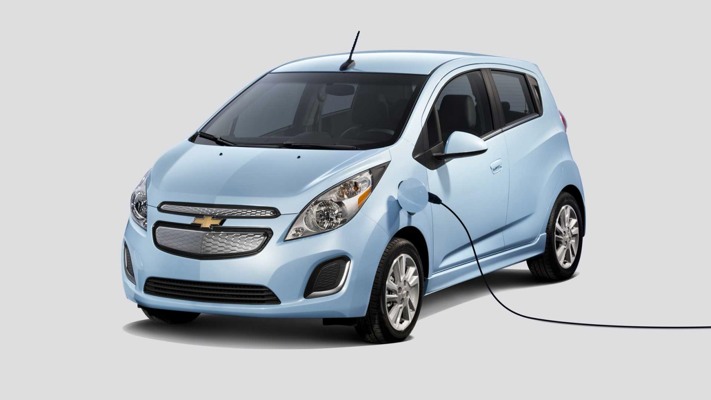After being smitten by the Nissan Leaf and impressed by the Ford Focus Electric, there’s a good chance that I’m going to settle on a 2014 Chevy Spark EV this week. This little electric car has a lot to love, but it also has a few drawbacks. On the plus side, the Chevy Spark EV is way more fun to drive than the Ford Focus Electric or Nissan Leaf. This car has a ton of torque and accelerates impressively from 0-45MPH. It’s also cheaper than its competitors, with Chevy offering a straight-up deal with minimal dealership…creativity.
The Chevy Spark EV also packs some nerdy features inside the car. The dashboard is totally geeked out, allowing you to see energy availability and consumption in various ways. There are basic readings that are completely straightforward. There are also more precise readings that allow you to see maximum and minimum charge remaining in addition to the mean, as well as energy consumption and regeneration in kilowatt hours. A customary CD player has been eschewed for smartphone connectivity. iPhone users can simply plug into the dashboard console via USB, allowing the car’s system to play music, answer calls, compose texts, use Siri hands-free, and provide a larger display for the optional BringGo GPS app.
On the downside, trunk space is the smallest of the three cars I’ve looked at and the backseat legroom is tight. The larger issue is charging. The Chevy Spark EV’s level 2 charge port is only 3.3kW, as opposed to the 6.6kW ports found on most 2014 and 2015 electric cars. In real-world terms, that means that an empty Chevy Spark EV battery will take roughly seven hours to fill via level 2 charging.
The potentially good news is that the car has a quick-charge option. The Chevy Spark EV is available with an SAE DC Combo port, which allows a full charge in 30 minutes. Unfortunately, this “standard” hasn’t proliferated nearly as fast as the CHAdeMO quick-charge ports used by Nissan, Mitsubishi, and Toyota. However, SAE DC Combo is back by some heavy hitters — Chevy, Ford, BMW, Mercedes, and Volkswagen. If I do pick up the Chevy Spark EV, I’ll be gambling on SAE DC Combo public chargers deploying rapidly over the next few years. It’s hardly a sure thing, but it could be a decent gamble.
In California, a few SAE DC Combo chargers have been deployed, with eVgo planning to set more up. The company has a ton of work to do in order to catch up with CHAdeMO operators like Blink and Chargepoint in Los Angeles. (Note: eVgo has a number of CHAdeMO charging stations in the LA area too.) Using the excellent Plugshare app, I found four CHAdeMO chargers within a four-mile radius of my apartment. The nearest SAE DC Combo charger is more than 20 miles away. If I do pick up the Chevy Spark EV, my driving will be limited until more SAE DC Combo chargers are deployed. According to an eVgo PR rep I contacted:
All of NRG eVgo’s Freedom Station sites have been pre-wired for the addition of a SAE Combo fast charger.
Our team is developing software integration with multiple vendors, testing chargers with automakers, and is beginning to install additional SAE pilots in California now which will be announced via the eVgo website as they come online. Our goal is to install SAE fast chargers across California.
We are well on track to have at least 200 fast-charging stations throughout California by the end of 2016, giving the state the most robust fast charging infrastructure in America.
Hopefully eVgo does what it says it’s going to do. Obviously, I’d love to believe the company, but I’m skeptical of most energy companies — even green ones.
In a perfect world, a Nissan dealer will call me tomorrow and give me a Leaf offer I can’t refuse. That’s extremely unlikely, so there’s a good chance that I’m going to settle on the Chevy Spark EV. It’s a fun car to drive and cheaper than the other two electric cars I test drove. Hopefully SAE DC Combo chargers multiply like Gremlins over the next year to help make up for the car’s slow-ass level 2 charging.
Before I make my final decision, I’d love to hear from you guys. Should I take the great offer I received on the Chevy Spark EV and live with its warts? Or should I hold out for a better offer on a Nissan Leaf. Leave a comment and let me know (please!).


